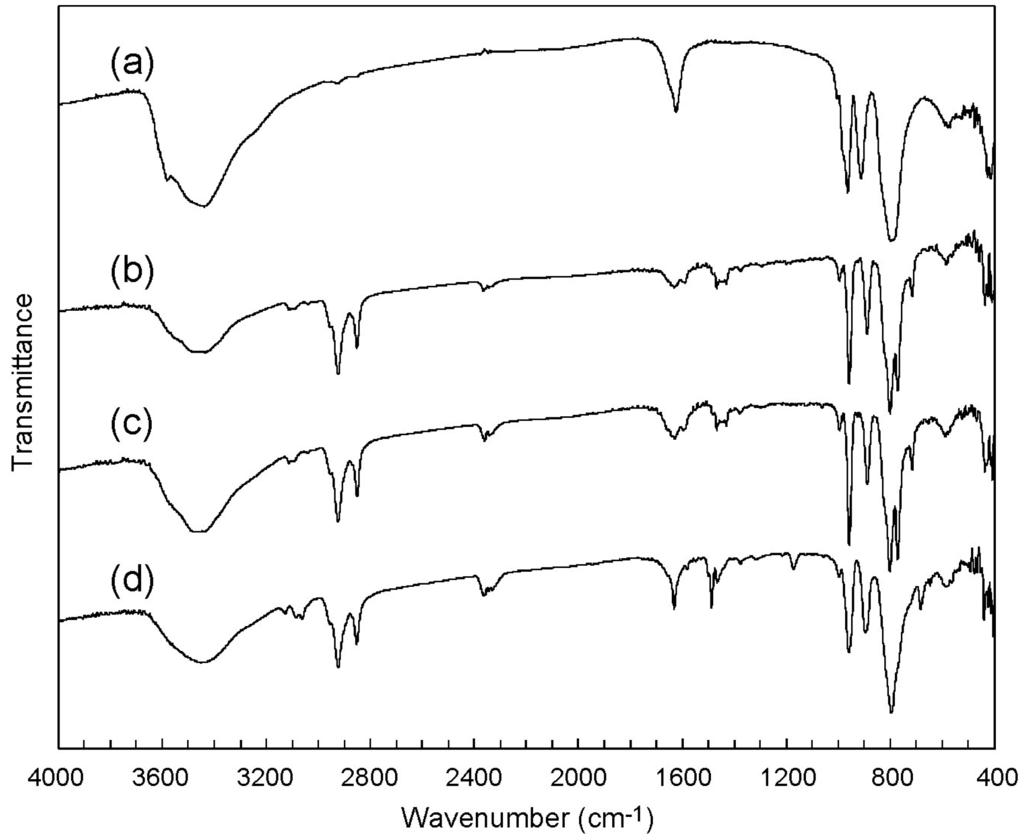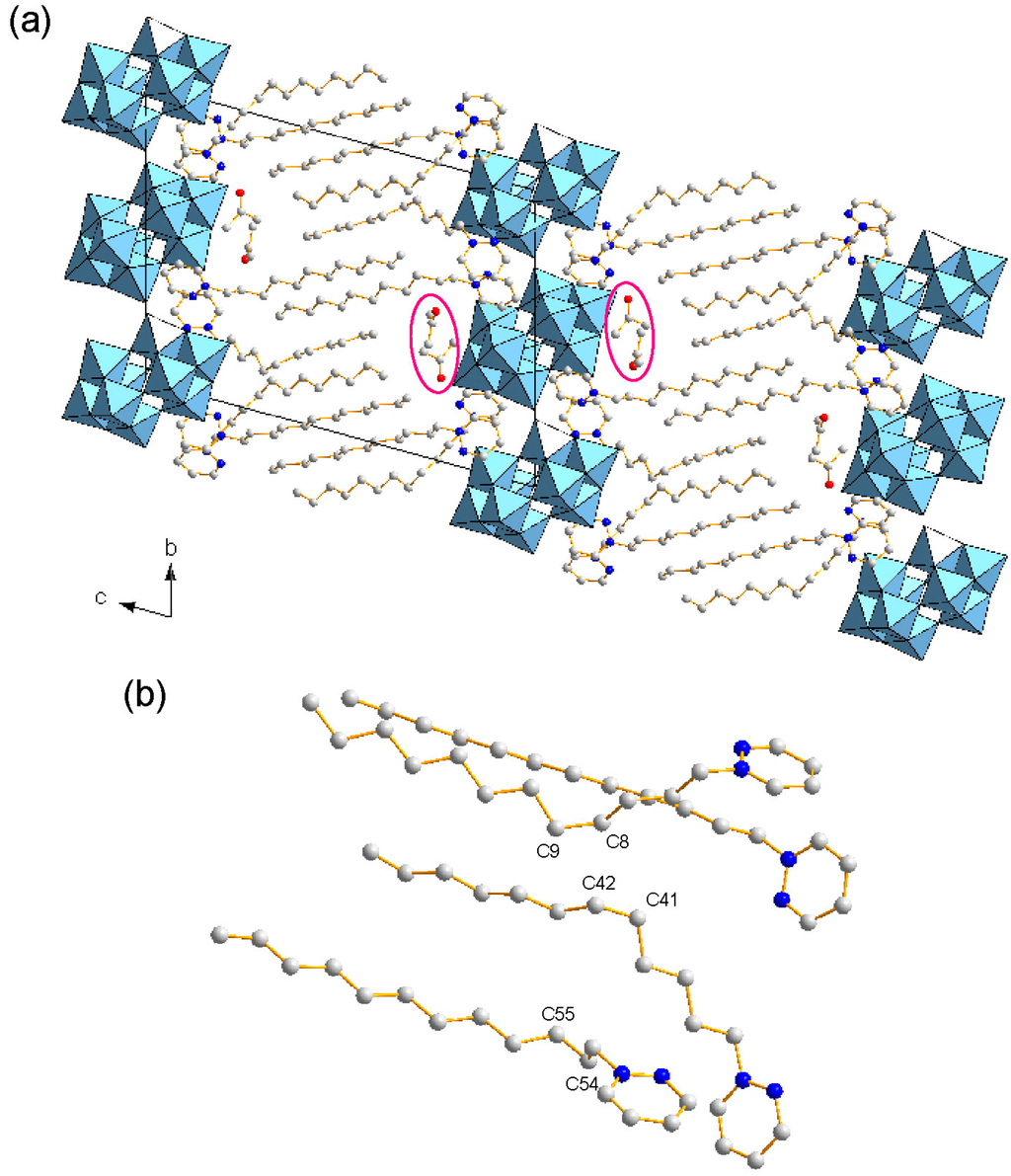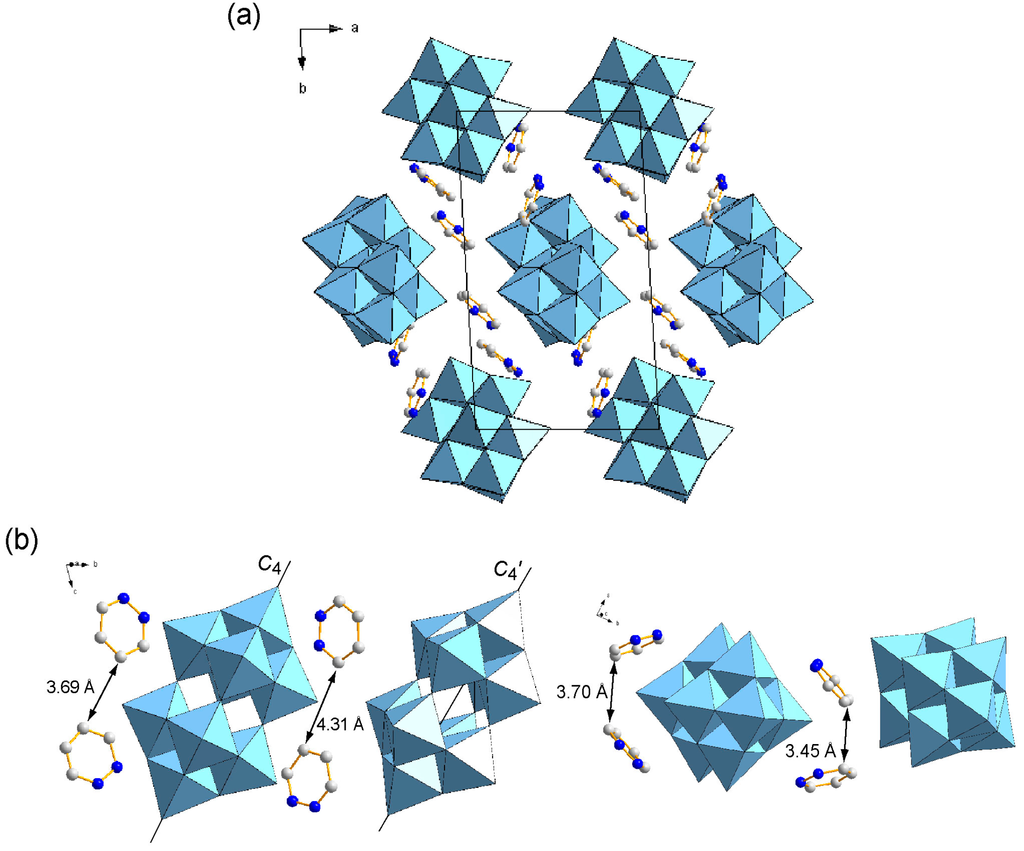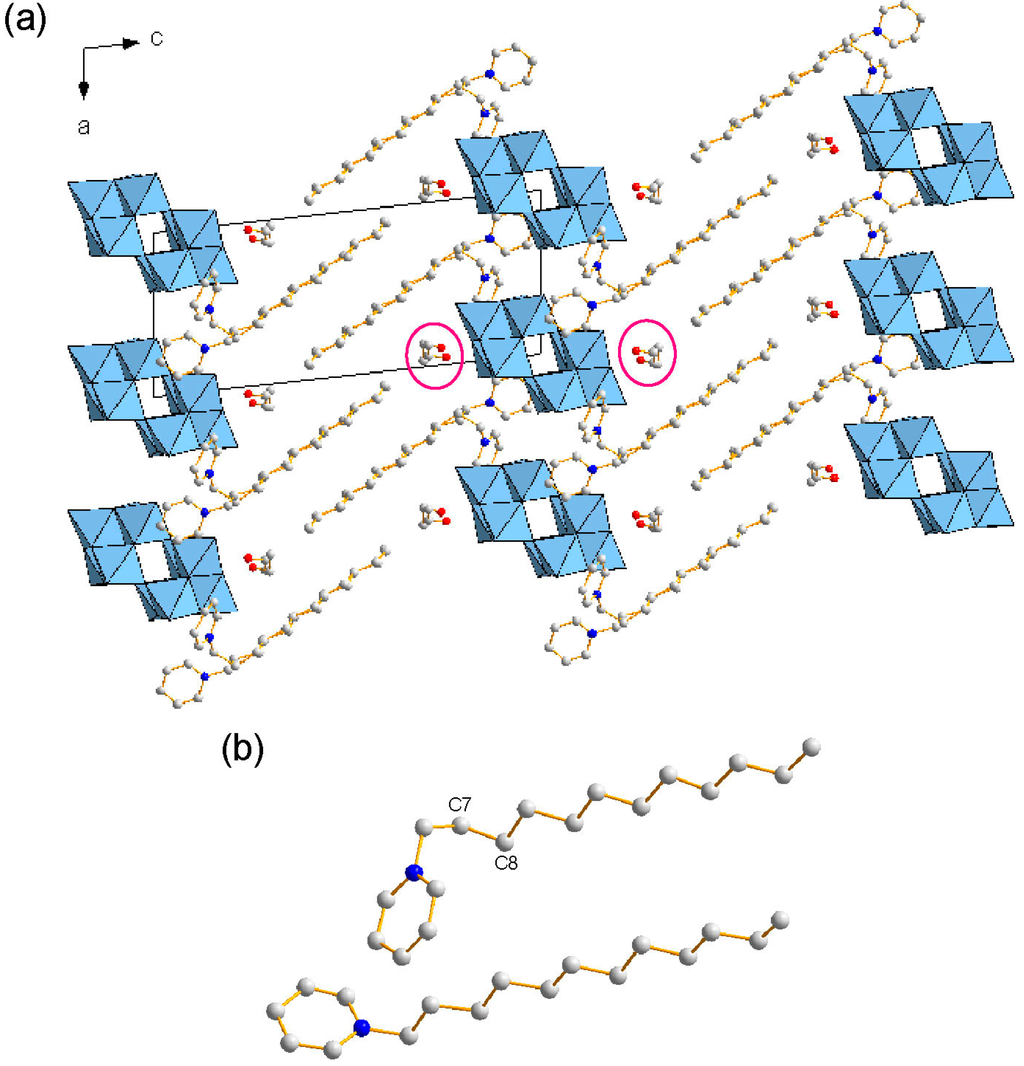Abstract
Inorganic-organic hybrid crystals were successfully obtained as single crystals by using polyoxotungstate anion and cationic dodecylpyridazinium (C12pda) and dodecylpyridinium (C12py) surfactants. The decatungstate (W10) anion was used as the inorganic component, and the crystal structures were compared. In the crystal comprising C12pda (C12pda-W10), the heterocyclic moiety directly interacted with W10, which contributed to a build-up of the crystal structure. On the other hand, the crystal consisting of C12py (C12py-W10) had similar crystal packing and molecular arrangement to those in the W10 crystal hybridized with other pyridinium surfactants. These results indicate the significance of the heterocyclic moiety of the surfactant to construct hybrid crystals with polyoxometalate anions.
1. Introduction
Weak chemical interactions, such as hydrogen bonding or van der Waals interactions, are crucial for the construction and function of biological molecules, such as proteins, DNA or RNA []. Employing these weak chemical interactions also provides effective options for building up synthetic molecular architectures [,,,]. To build up such molecular architectures, organic molecules or ligands are often used due to synthetic flexibility to control the directions and intensity of the weak chemical interactions. However, all-organic molecular architectures are less stable in the intermediate temperature (>100 °C) regions.
Inorganic-organic hybrid materials are more structurally stable than purely organic compounds owing to inorganic components, and the synergy of inorganic and organic characteristics will benefit constructing functional materials []. Conductive hybrid compounds composed of organic cations and inorganic anions have been reported, where the emergence of conductive functions is prompted by precise control of the molecular structures and arrangements of the components []. The precisely controlled inorganic-organic materials have been obtained as crystalline materials.
As a molecular inorganic component, polyoxometalates (POMs) are promising candidates with respect to their structural and functional controllability [,,,,,,,,]. POMs with various physicochemical properties have been successfully hybridized by structure-directing surfactants [,,] to construct inorganic-organic crystalline hybrids [,,,,] and single crystals [,,,,,,,,,]. Among several POM-surfactant single crystals, utilizing surfactants with a heterocyclic moiety enables the precise control of the composition and structure [,,]. However, the variation of the surfactants has been limited to pyridinium and imidazolium cations.
Here, we report the syntheses and structures of polyoxotungstate hybrid crystals containing heterocyclic surfactants, including the first example of a POM-surfactant crystal comprised of a pyridazinium surfactant. The decatungstate ([W10O32]4−, W10) anion was hybridized with dodecylpyridazinium ([C4H4N2(C12H25)]+, C12pda) and dodecylpyridinium ([C5H5N(C12H25)]+, C12py) to form the crystals of C12pda-W10 (1) and C12py-W10 (2), respectively, and their chemical interactions and molecular arrangements were compared by X-ray structure analyses.
2. Results and Discussion
2.1. Crystal Structure of C12pda-W10 (1)
C12pda-W10 (1) was obtained by the cation exchange reaction of sodium salt of the W10 anion (Na-W10). The retention of the W10 structure before and after the recrystallization was confirmed by infrared (IR) spectra, which exhibited the characteristic peaks in the range of 400–1000 cm−1 (Figure 1a–c). Suitable single crystals for X-ray crystallography were obtained by employing acetone as the crystallization solvent.
The X-ray structure and elemental analyses revealed the formula of 1 to be [C4H4N2(C12H25)]4[W10O32]·2(CH3)2CO (Table 1). Four C12pda cations (1+ charge) were associated with one W10 anion (4− charge) due to the charge compensation. Figure 2 shows the crystal structure of 1. The crystal packing consisted of alternating W10 inorganic monolayers and C12pda organic bilayers with a periodicity of 24.5 Å (Figure 2a). The acetone molecules were placed at the interface between the W10 and C12pda layers, being excluded from the inorganic layers. Although most C-C bonds of the dodecyl chains of C12pda had the anti conformation, three C-C bonds (C8-C9, C41-C42, C54-C55) had the gauche conformation (Figure 2b), two of which (C8-C9, C41-C42) were located at some methylene groups far away from the hydrophilic head.

Figure 1.
IR spectra of W10 compounds. (a) Na-W10 as a starting material; (b) As-prepared sample of 1; (c) 1 after recrystallization; (d) As-prepared sample of 2.

Table 1.
Crystallographic data.
| Compound | 1 | 2 |
|---|---|---|
| Chemical formula | C70H128N8W10O34 | C76H140N4W10O36 |
| Formula weight | 3464.31 | 3524.45 |
| Crystal system | triclinic | triclinic |
| Space group | P (No.2) | P (No.2) |
| a (Å) | 10.55918(19) | 10.813(7) |
| b (Å) | 18.7700(3) | 11.339(7) |
| c (Å) | 25.4318(5) | 23.610(13) |
| α (°) | 74.4842(7) | 99.415(9) |
| β (°) | 86.5737(7) | 91.558(5) |
| γ (°) | 85.6363(7) | 115.588(9) |
| V (Å3) | 4838.62(15) | 2560(3) |
| Z | 2 | 1 |
| ρcalcd (g·cm−3) | 2.378 | 2.286 |
| T (K) | 193 | 173 |
| μ (Mo·Kα) (mm−1) | 11.924 | 11.272 |
| No. of reflections measured | 78,035 | 18,275 |
| No. of independent reflections | 22,146 | 11,774 |
| Rint | 0.0900 | 0.1384 |
| No. of parameters | 1106 | 563 |
| R1 (I > 2σ(I)) | 0.0452 | 0.0983 |
| wR2 (all data) | 0.1162 | 0.3237 |

Figure 2.
Crystal structure of 1 (C: gray, N: blue; W10 anions in polyhedral representations. H atoms are omitted for clarity). (a) Packing diagram along the a axis. Some acetone molecules are highlighted; (b) View of crystallographically-independent surfactant molecules.
The hydrophilic heads of C12pda penetrated into the W10 inorganic layers and isolated each W10 anion (Figure 3a) in a similar way to that in the crystal of hexadecylpyridinium ([C5H5N(C16H33)]+, C16py) and W10 (C16py-W10, 3) []. However, the conformations of the heterocyclic moiety were different. In 1, the pyridazine rings of the C12pda cations were not in the vicinity of each other (Figure 3b), as in the case of the POM crystal comprising the pyridazinium cation without a long alkyl chain []. This indicates that there were no interactions, such as π–π stacking or the C-H···π interaction, between the heterocyclic moiety, being different from 2 (see below) and 3. On the other hand, the pyridazine rings of C12pda interacted rather more directly with the W10 anions. The crystals of 1 had several short contacts between of O atoms of W10 and C or N atoms of the pyridazine ring (2.88–3.22 Å (mean: 3.09 Å); Table 2), indicating the direct interactions between W10 and the heterocyclic moiety of C12pda. The alignment of two crystallographically-independent W10 anions was not parallel, and the angle between the molecular C4 axes was 8.3° (Figure 3b).

Figure 3.
Molecular arrangements in the inorganic layers of 1 (C: gray, N: blue; W10 anions in polyhedral representations. H atoms and the dodecyl groups are omitted for clarity). (a) Packing diagram along the c axis; (b) View of crystallographically-independent pyridazinium moieties of surfactants in the vicinity of the W10 anions.

Table 2.
Short contacts between W10 and the heterocyclic moiety of C12pda in 1.
| Contact a | Distance (Å) | Contact a | Distance (Å) |
|---|---|---|---|
| C20i···O1 | 3.206 | C2···O13 | 3.118 |
| C20i···O2 | 3.085 | C51iv···O13 | 3.201 |
| C4···O5 | 3.210 | C33i···O20 | 3.177 |
| C19i···O5 | 3.147 | C49···O22 | 2.914 |
| C33ii···O6 | 3.140 | C4···O24 | 2.886 |
| C34ii···O6 | 3.180 | C17···O25 | 2.894 |
| C50iii···O7 | 2.876 | C3ii···O27 | 3.216 |
| C51iii···O7 | 3.110 | C19ii···O27 | 3.163 |
| C34iii···O8 | 3.134 | C33i···O27 | 3.142 |
| C4···O9 | 3.183 | C17i···O28 | 3.135 |
| C3···O9 | 2.890 | C20···O29 | 3.119 |
| N8iii···O12 | 3.046 | N6···O30 | 2.909 |
a Contact between O atoms of W10 and C or N atoms of the pyridazine ring of C12pda. Symmetry codes: (i) 1 + x, y, z; (ii) −x, −y, 2 − z; (iii) 1+x, −1 + y, z; (iv) x, −1 + y, z.
In the crystal of 1, The C12pda cations had weak C-H···O hydrogen bonds []. Some C-H···O bonds were present in the vicinity of the gauche C-C bonds. The C···O distances were in the range of 2.89–3.74 Å (mean value: 3.32 Å), being much shorter than those of 2 (see below). In addition, most C-H···O hydrogen bonds were formed between W10 and the hydrophilic head of C12pda, i.e., the pyridazine ring of C12pda. This suggests stronger interactions between W10 and the heterocyclic moiety of the surfactant in 1 than in 2. These hydrogen bonds, as well as the electrostatic interaction between W10 and the heterocyclic moiety of C12pda stabilized the layered crystal structure of C12pda-W10 with rigid packing.
2.2. Crystal Structure of C12py-W10 (2)
C12py-W10 (2) was also synthesized by the cation exchange reaction of Na-W10 (Figure 1d). The molecular structure of W10 was retained before and after the recrystallization, as in the case of C16py-W10 (3) []. Although the recrystallization of 2 was difficult, some crystals obtained from ethanol were able to be analyzed by X-ray crystallography.
The formula of 2 was revealed to be [C5H5N(C12H25)]4[W10O32]·4C2H5OH (Table 1). Four C12py cations (1+ charge) were associated with one W10 anion (4− charge), being similar to 1 and 3. The crystal packing of 2 consisted of alternating W10 inorganic monolayers and C12py organic bilayers with a distance of 23.2 Å (Figure 4a). Surprisingly, the cell parameters and the layered distances of 2 and 3 [] were quite similar, even if the length of the pyridinium surfactants were changed to C12py (2) from C16py (3). The vacant spaces produced by changing to the shorter surfactant for 2 were filled by the ethanol molecules located at the interface between the W10 and C12py layers. This similarity of the layered structures led to the similar molecular arrangements of W10 and the pyridine rings (see below). All C-C bonds in the dodecyl chains showed the anti conformation except one C-C bond (C7-C8) near the hydrophilic head of C12py, being similar to that in 3 (Figure 4b).

Figure 4.
Crystal structure of 2 (C: gray, N: blue; W10 anions in polyhedral representations. H atoms are omitted for clarity). (a) Packing diagram along the b axis. Some ethanol molecules are highlighted; (b) View of crystallographically-independent surfactant molecules in 2.
The hydrophilic heads of C12py penetrated into the W10 inorganic layers in 2 (Figure 5a), which was almost the same manner as observed in 3. The alignment of each W10 anion was parallel, being similar to 3, but different from 1. The penetrated C12py cations formed two crystallographically-independent pairs (Figure 5b). The two C12py cations interacted weakly through the C-H···π interaction, where the shortest interatomic distance was 2.91 Ǻ for C3···H20 (Figure 5b). In the crystal of 2, there were short contacts between W10 and the pyridine ring (2.93–3.22 Å (mean: 3.07 Å), Table 3). 2 also had C-H···O hydrogen bonds at the interface between the W10 and C12py layers (C···O distance: 3.03–3.88 Å; mean value: 3.52 Å), being much longer than those observed in 1. These longer C-H···O hydrogen bonds were formed around W10 and the pyridine ring of C12py, indicating that the interactions between W10 and the heterocyclic moiety in 2 were weaker than in 1. The structure of the heterocyclic moiety in the surfactants is the significant factor to construct the POM-surfactant hybrid crystals.

Figure 5.
Molecular arrangements in the inorganic layers of 2 (C: gray, N: blue, H: white; W10 anions in polyhedral representations. The dodecyl groups are omitted for clarity). (a) Packing diagram along the c axis. H atoms are omitted for clarity; (b) View of crystallographically-independent pyridinium moieties of surfactants in the vicinity of the W10 anions. The selected short contact is presented as a pink dotted line.

Table 3.
Short contacts between W10 and the heterocyclic moiety of C12py in 2.
| Contact a | Distance (Å) | Contact a | Distance (Å) |
|---|---|---|---|
| C22···O5 | 3.153 | C20ii···O11 | 3.026 |
| N2i···O9 | 2.929 | N1iii···O14 | 2.960 |
| C18i···O9 | 2.980 | C5iii···O14 | 3.203 |
| C22i···O9 | 3.108 | C21iv···O14 | 3.091 |
| C2···O11 | 3.220 | C18v···O16 | 3.031 |
a Contact between O atoms of W10 and C or N atoms of the pyridine ring of C12py. Symmetry codes: (i) −1 + x, y, z; (ii) 1 − x, 1 − y, −z; (iii) x, −1 + y, z; (iv) 1 − x, −y, −z; (v) −1 + x, −1 + y, z.
3. Experimental Section
3.1. Syntheses and Methods
All chemical reagents were obtained from commercial sources (Wako, Osaka, Japan). [C4H4N2(C12H25)]Br (C12pda·Br) was synthesized by using pyridazine and 1-bromododecane based on the literature []. Na4[W10O32] (Na-W10) was synthesized by combining a boiled solution of Na2WO4·2H2O (0.5 M, 25 mL) and boiled HCl (1 M, 25 mL) [].
C12pda-W10 (1) was synthesized by the cation exchange of Na-W10. Na-W10 (0.50 g, 0.20 mmol) was dissolved in 20 mL of HCl (pH = 2), and ethanol solution containing 0.27 g (0.81 mmol) of C12pda·Br was added. After stirring for 10 min, the obtained white precipitates were filtered and dried. Recrystallization of the crude product from hot acetone gave colorless plates of 1. The crystals of 1 were efflorescent, and its elemental composition was calculated for the formula without the solvent of crystallization. Data for 1: anal. calcd. for C64H116N8W10O32: C, 22.96; H, 3.49; N, 3.35%; found: C, 22.77; H, 3.36; N, 3.33%. IR (KBr disk): 996 (w), 958 (s), 889 (m), 800 (s), 772 (s), 589 (w), 437 (m), 407 (m) cm−1.
C12py-W10 (2) was synthesized by a similar procedure as for 1. [C5H5N(C12H25)]Br (C12py·Br, 0.28 g (0.81 mmol)) was employed as the cationic surfactant. The crude product was recrystallized from ethanol to obtain colorless prisms of 2, which were efflorescent. Data for 1: anal. calcd. for C76H120N4W10O32: C, 24.42; H, 3.62; N, 1.68%; found: C, 24.01; H, 3.42; N, 1.62%. IR (KBr disk): 997 (w), 959 (s), 895 (m), 796 (s), 683 (m), 584 (w), 440 (m), 410 (m) cm−1.
3.2. X-ray Diffraction Measurements
Single-crystal X-ray diffraction measurements for 1 were made on a Rigaku RAXIS RAPID imaging plate diffractometer with graphite monochromated Mo-Kα radiation (λ = 0.71075 Å). Diffraction data were collected and processed with PROCESS-AUTO []. The structure of 1 was solved by the charge flipping method [] and expanded using Fourier techniques. The refinement procedure was performed by the full-matrix least-squares using SHELXL97 []. The measurements for 2 were made on a Rigaku Saturn70 diffractometer using graphite monochromated Mo-Kα radiation. Diffraction data were collected and processed with CrystalClear []. The structure of 2 was solved by direct methods [] and expanded using Fourier techniques. The refinement procedure was performed by full-matrix least-squares using SHELXL2013 []. All calculations were performed using the CrystalStructure [] software package. In the refinement procedure, all non-hydrogen atoms, except for C37 of 2, were refined anisotropically, and the hydrogen atoms on C atoms were located in the calculated positions. The weak reflection intensities from the crystals of 2 may result in relatively high R1 and wR2 values. The results of checking cif files are available as supplementary materials. Further details of the crystal structure investigation may be obtained free of charge from the Cambridge Crystallographic Data Centre, 12 Union Road, Cambridge CB2 1EZ, UK; Fax: +44 1223 336 033; or E-Mail: deposit@ccdc.cam.ac.uk (CCDC 1055676-1055677).
4. Conclusions
Inorganic-organic hybrid crystals comprised of polyoxotungstate and surfactants having a heterocyclic moiety, [C4H4N2(C12H25)]4[W10O32]·2(CH3)2CO (1) and [C5H5N(C12H25)]4[W10O32]·4C2H5OH (2), were successfully synthesized. Dodecylpyridazinium (C12pda) and dodecylpyridinium (C12py) were utilized as organic cations, and the decatungstate anion (W10) was used for the inorganic component, which enabled the discussion of the effect of the heterocyclic moiety for the construction of the hybrid crystals. Although both hybrid crystals contained alternate stacking of W10 monolayers and interdigitated surfactant bilayers, pyridazine rings in 1 interacted more strongly with the W10 anions. 1 contained shorter C-H···O hydrogen bonds than those observed in 2, indicating that these hydrogen bonds, as well as the electrostatic interaction between the C12pda cation and the W10 anion stabilized the layered structure of C12pda-W10 with rigid packing. On the other hand, 2 has similar cell parameters and molecular arrangements as those in the crystals of hexadecylpyridinium (C16py) and W10 (3), also indicating the significance of the heterocyclic moiety for the construction of the hybrid crystals. The difference between the heterocyclic moieties led to different arrangements of W10 anions in 1 and 2, which will contribute to the precise control of molecular arrangements and the emergence of characteristic conductivity.
Supplementary Materials
Supplementary materials can be found at http://www.mdpi.com/1422-0067/16/04/8505/s1.
Acknowledgments
This work was supported in part by the JSPS Grant-in-Aid for Scientific Research (No. 26410245) and the Research and Study Project of Tokai University Educational System General Research Organization.
Author Contributions
Saki Otobe and Takeru Ito conceived of and designed the experiments. Saki Otobe, Natsumi Fujioka and Takuro Hirano performed the experiments. Saki Otobe and Takeru Ito analyzed the data. Eri Ishikawa and Haruo Naruke contributed analysis tools. Katsuhiko Fujio contributed materials. Takeru Ito wrote the paper.
Conflicts of Interest
The authors declare no conflict of interest.
References
- Desiraju, G.R.; Steiner, T. The Weak Hydrogen Bond in Structural Chemistry and Biology; Oxford University Press: New York, NY, USA, 1999. [Google Scholar]
- Cockroft, S.L.; Hunter, C.A. Chemical double-mutant cycles: Dissecting non-covalent interactions. Chem. Soc. Rev. 2007, 36, 172–188. [Google Scholar] [CrossRef] [PubMed]
- Rebek, J., Jr. Simultaneous encapsulation: Molecules held at close range. Angew. Chem. Int. Ed. 2005, 44, 2068–2078. [Google Scholar] [CrossRef]
- Maurizot, V.; Yoshizawa, M.; Kawano, M.; Fujita, M. Control of molecular interactions by the hollow of coordination cages. Dalton Trans. 2006, 2006, 2750–2756. [Google Scholar] [CrossRef]
- Rosen, B.M.; Wilson, C.J.; Wilson, D.A.; Peterca, M.; Imam, M.R.; Percec, V. Dendron-mediated self-assembly, disassembly, and self-organization of complex systems. Chem. Rev. 2009, 109, 6275–6540. [Google Scholar] [CrossRef] [PubMed]
- Coronado, E.; Gómez-García, C.J. Polyoxometalate-based molecular materials. Chem. Rev. 1998, 98, 273–296. [Google Scholar] [CrossRef] [PubMed]
- Coronado, E.; Giménez-Saiz, C.; Gómez-García, C.J. Recent advances in polyoxometalate-containing molecular conductors. Coord. Chem. Rev. 2005, 249, 1776–1796. [Google Scholar] [CrossRef]
- Pope, M.T. Heteropoly and Isopoly Oxometalates; Springer: Berlin, Germany, 1983. [Google Scholar]
- Hill, C.L. Polyoxometalates. Chem. Rev. 1998, 98, 1–390. [Google Scholar] [CrossRef] [PubMed]
- Long, D.-L.; Burkholder, E.; Cronin, L. Polyoxometalate clusters, nanostructures and materials: From self assembly to designer materials and devices. Chem. Soc. Rev. 2007, 36, 105–121. [Google Scholar] [CrossRef] [PubMed]
- Proust, A.; Matt, B.; Villanneau, R.; Guillemot, G.; Gouzerh, P.; Izzet, G. Functionalization and post-functionalization: a step towards polyoxometalate-based materials. Chem. Soc. Rev. 2012, 41, 7605–7622. [Google Scholar] [CrossRef] [PubMed]
- Okuhara, T.; Mizuno, N.; Misono, M. Catalytic chemistry of heteropoly compounds. Adv. Catal. 1996, 41, 113–252. [Google Scholar]
- Sadakane, M.; Steckhan, E. Electrochemical properties of polyoxometalates as electrocatalysts. Chem. Rev. 1998, 98, 219–237. [Google Scholar] [CrossRef] [PubMed]
- Song, Y.-F.; Long, D.-L.; Ritchie, C.; Cronin, L. Nanoscale polyoxometalate-based inorganic/organic hybrids. Chem. Rec. 2011, 11, 158–171. [Google Scholar] [CrossRef] [PubMed]
- Qi, W.; Wu, L. Polyoxometalate/polymer hybrid materials: fabrication and properties. Polym. Int. 2009, 58, 1217–1225. [Google Scholar] [CrossRef]
- Clemente-León, M.; Coronado, E.; Soriano-Portillo, A.; Mingotaud, C.; Dominguez-Vera, J.M. Langmuir–Blodgett films based on inorganic molecular complexes with magnetic or optical properties. Adv. Colloid Interface Sci. 2005, 116, 193–203. [Google Scholar] [CrossRef] [PubMed]
- Huo, Q.; Margolese, D.I.; Ciesla, U.; Demuth, D.G.; Feng, P.; Gier, T.E.; Sieger, P.; Firouzi, A.; Chmelka, B.F.; Schüth, F.; et al. Organization of organic molecules with inorganic molecular species into nanocomposite biphase arrays. Chem. Mater. 1994, 6, 1176–1191. [Google Scholar] [CrossRef]
- Kanatzidis, M.G. Beyond silica: Nonoxidic mesostructured materials. Adv. Mater. 2007, 19, 1165–1181. [Google Scholar] [CrossRef]
- Yamauchi, Y.; Kuroda, K. Rational design of mesoporous metals and related nanomaterials by a soft-template approach. Chem. Asian J. 2008, 3, 664–676. [Google Scholar] [CrossRef] [PubMed]
- Stein, A.; Fendorf, M.; Jarvie, T.P.; Mueller, K.T.; Benesi, A.J.; Mallouk, T.E. Salt-gel synthesis of porous transition-metal oxides. Chem. Mater. 1995, 7, 304–313. [Google Scholar] [CrossRef]
- Janauer, G.G.; Dobley, A.; Guo, J.; Zavalij, P.; Whittingham, M.S. Novel tungsten, molybdenum, and vanadium oxides containing surfactant ions. Chem. Mater. 1996, 8, 2096–2101. [Google Scholar] [CrossRef]
- Taguchi, A.; Abe, T.; Iwamoto, M. Non-silica-based mesostructured materials: hexagonally mesostructured array of surfactant micelles and 11-tungstophosphoric heteropoly anions. Adv. Mater. 1998, 10, 667–669. [Google Scholar] [CrossRef]
- Landsmann, S.; Lizandara-Pueyo, C.; Polarz, S. A new class of surfactants with multinuclear, inorganic head groups. J. Am. Chem. Soc. 2010, 132, 5315–5321. [Google Scholar] [CrossRef] [PubMed]
- Zhang, G.; Ke, H.; He, T.; Xiao, D.; Chen, Z.; Yang, W.; Yao, J. Synthesis and characterization of new layered polyoxometallates–1,10-decanediamine intercalative nanocomposites. J. Mater. Res. 2004, 19, 496–500. [Google Scholar] [CrossRef]
- Janauer, G.G.; Dobley, A.D.; Zavalij, P.Y.; Whittingham, M.S. Evidence for decavanadate clusters in the lamellar surfactant ion phase. Chem. Mater. 1997, 9, 647–649. [Google Scholar] [CrossRef]
- Spahr, M.E.; Nesper, R. Anhydrous octamolybdate with trimethyl hexadecyl ammonium cations. Z. Anorg. Allg. Chem. 2001, 627, 2133–2138. [Google Scholar] [CrossRef]
- Nyman, M.; Ingersoll, D.; Singh, S.; Bonhomme, F.; Alam, T.M.; Brinker, C.J.; Rodriguez, M.A. Comparative study of inorganic cluster-surfactant arrays. Chem. Mater. 2005, 17, 2885–2895. [Google Scholar] [CrossRef]
- Nyman, M.; Rodriguez, M.A.; Anderson, T.M.; Ingersoll, D. Two structures toward understanding evolution from surfactant-polyoxometalate lamellae to surfactant-encapsulated polyoxometalates. Cryst. Growth Des. 2009, 9, 3590–3597. [Google Scholar] [CrossRef]
- Yin, P.; Wu, P.; Xiao, Z.; Li, D.; Bitterlich, E.; Zhang, J.; Cheng, P.; Vezenov, D.V.; Liu, T.; Wei, Y. A double-tailed fluorescent surfactant with a hexavanadate cluster as the head group. Angew. Chem. Int. Ed. 2011, 50, 2521–2525. [Google Scholar] [CrossRef]
- Ito, T.; Sawada, K.; Yamase, T. Crystal structure of bis(dimethyldioctadecylammonium) hexamolybdate: a molecular model of Langmuir–Blodgett films. Chem. Lett. 2003, 32, 938–939. [Google Scholar] [CrossRef]
- Ito, T.; Mikurube, K.; Abe, Y.; Koroki, T.; Saito, M.; Iijima, J.; Naruke, H.; Ozeki, T. Hybrid inorganic-organic crystals composed of octamolybdate isomers and pyridinium surfactant. Chem. Lett. 2010, 39, 1323–1325. [Google Scholar] [CrossRef]
- Ito, T.; Fujimoto, N.; Uchida, S.; Iijima, J.; Naruke, H.; Mizuno, N. Polyoxotungstate-surfactant layered crystal toward conductive inorganic-organic hybrid. Crystals 2012, 2, 362–373. [Google Scholar] [CrossRef]
- Ito, T.; Ide, R.; Kosaka, K.; Hasegawa, S.; Mikurube, K.; Taira, M.; Naruke, H.; Koguchi, S. Polyoxomolybdate-surfactant layered crystals derived from long-tailed alkylamine and ionic-liquid. Chem. Lett. 2013, 42, 1400–1402. [Google Scholar] [CrossRef]
- Ito, T. Polyoxometalate-surfactant hybrids as building strategy for two-dimensional molecular arrays. Polyoxometalate Chem. 2012, 1, 6–14. [Google Scholar]
- Ugalde, M.; Gutiérrez-Zorrilla, J.M.; Vitoria, P.; Luque, A.; Wéry, A.S.J.; Román, P. Synthesis, crystal structure, and thermal behavior of organically templated three-dimensional tunnel structures based on α-Keggin phosphododecamolybdate and diazines. Chem. Mater. 1997, 9, 2869–2875. [Google Scholar] [CrossRef]
- Fujio, K.; Ikeda, S. Size of spherical micelles of dodecylpyridinium bromide in aqueous NaBr solutions. Langmuir 1991, 7, 2899–2903. [Google Scholar] [CrossRef]
- Renneke, R.F.; Pasquali, M.; Hill, C.L. Polyoxometalate systems for the catalytic selective production of nonthermodynamic alkenes from alkanes nature of excited-state deactivation processes and control of subsequent thermal processes in polyoxometalate photoredox chemistry. J. Am. Chem. Soc. 1990, 112, 6585–6594. [Google Scholar] [CrossRef]
- Rigaku Corporation. PROCESS-AUTO, Rigaku Corporation: Tokyo, Japan, 2002.
- Palatinus, L.; Chapuis, G. SUPERFLIP—A computer program for the solution of crystal structures by charge flipping in arbitrary dimensions. J. Appl. Cryst. 2007, 40, 786–790. [Google Scholar] [CrossRef]
- Sheldrick, G.M. SHELX97. A short history of SHELX. Acta Cryst. 2008, A64, 112–122. [Google Scholar] [CrossRef]
- Rigaku Corporation. CrystalClear, Rigaku Corporation: Tokyo, Japan, 1999.
- Sheldrick, G.M. SHELX2013. A short history of SHELX. Acta Cryst. 2008, 112, 112–122. [Google Scholar] [CrossRef]
- Rigaku Corporation. CrystalStructure 4.1, Rigaku Corporation: Tokyo, Japan, 2014.
© 2015 by the authors; licensee MDPI, Basel, Switzerland. This article is an open access article distributed under the terms and conditions of the Creative Commons Attribution license (http://creativecommons.org/licenses/by/4.0/).